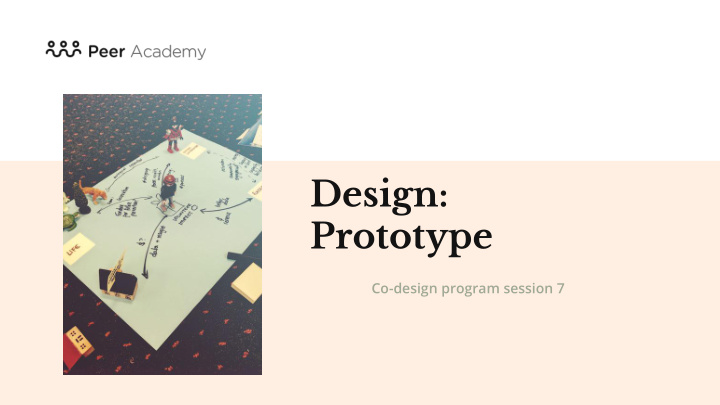



Design: Prototype Co-design program session 7
Check-in Take 2 minutes to consider: What did you notice during your ideation work over the last week ● Why is this a challenge or an opportunity for you right now? ● What is the intention you hold for today’s session? ● 2
Progress Update Team guide to share: What did you do between sessions? ● Where did you get stuck? ● How did you overcome this? ● 3
Program Overview By utilising deep reflection and practical application we can work to immediately apply our skills into real world projects. Each 2.5 hour sessions, we will learn essential co-design skills and tools and between the weeks, we will apply our learnings to our real world projects. 4
Agenda Share & capture ● Converge on potential ● Develop our top seed idea ● Rapid prototype our idea ● Pitch your prototype ● Next Steps ● 5
Prototyping in Practice 6
7
8
Share & Capture Examine the outcomes of your ideation session: Capture the new ideas on post-its ● One idea per post-it ● Keep it brief ● Add the top ideas from this to your existing pool of ideas ● Discuss the outcomes of your idea testing, what do ● you need to change or refine about your seed ideas 9
Converge Caution: Go with the evidence from your testing and with your gut ● Move quickly to a TOP 5 ● The combination MUST make sense. Negotiate to a Top 1 or top combination of ideas ● It must have an overarching connecting factor. Be ruthless!! Too many unconnected factors will dilute the power of a great idea 10
Nurturing Seed ideas These ideas are early, fragile ideas Building to Think ● Prototype them to bring them to life ● Preserve their most fragile core - the part of the idea that’s ● interesting, curious, different and compelling Maintain optimism, avoid smothering them with business as ● usual thinking or black hat thinking 11
Nurturing Seed ideas Three questions to ask about your seed idea: Is it an aspiration? ● Is it an idea that is simple, concrete, tangible and ● specific Does it clearly respond to the Problem Statement and ● the How Might We…? 12
Break 5 mins 13
Prototyping “Prototyping is the conversation you have with your ideas…” (Tom Wujec) 14
Design: Prototype Tools for prototyping Scale models ● Wireframes ● Bodystorming ● Story Boarding ● Mock Service Touchpoints ● Role Play ● 15
Tool: Rapid Prototyping 1. Use the materials provided to prototype your solution 2. Even if you aren’t sure what you’re doing or what you are going to create pick up some materials and just make something 3. Don’t make it perfect, make it rough and ready! You have 10 minutes 16
Tool: Prototype Development Template Work together to complete the Idea Development Template: 1. Copy in your problem statement and How Might We…? 2. Populate the boxes 3. Aim for succinct statements or high level dot-points 4. Add as much information as you need to, but keep the detail light enough to keep moving!! 5. Storyboard your user’s ideal journey through engagement with your solution 17
Tool: Refine - Zoom In Reflect on what you have created: 1. Use your Prototype Development Template to help you to zoom in on particular elements of your prototype 2. Develop your prototype further as you go 3. Make sure your end-user is in the forefront of your mind! 18
Reflect In your teams, debrief for 5 minutes on the interview you just completed: 1. What has the experience of converging been like? 2. What was challenging about the activity? 3. What was surprising? 4. How has the process facilitated this insight? 19
Prototyping “Testing potential interventions early on... and creating small things that represent an aspect of the policy” (Vacant Chari, Policy Lab) 20
Prototyping Reminder: Prototyping is fast and lean Try to always prototype with It’s about taking low risk and low investment steps end-users It’s about building to think and failing to learn It’s a great way to get them involved and an easy way for them to communicate their needs and ideas without words 21
Tool: Elevator Pitch Take 5 minutes now to hone your pitch around the following elements: Problem ● Opportunity ● Solution ● Benefits ● How it solves the problem ● You’ll have 3 minutes to pitch 22
Testing prototypes Go beyond simply asking if they Testing in co-design is about enquiring really deeply, ask lots like your idea or not, and for of questions, take paper and pens to map, draw or storyboard them to give you some feedback the idea with the end-user Try Asking: How would you see this idea play out in the real world? ● What works about this idea? ● What isn’t clear about this idea? ● What’s the potential of this idea? ● What else could this idea do? ● 23
Next session Complete the Prototype Phase of Design and step into the final phase: Influence Converge around the prototype you generated ● this week based on the testing you do Iterate your prototype as part of converging ● Experience a framework for storytelling to ● influence with Kylie Long 24
Homework Between now and our next session, it’s time for you to apply your learning to your real world project: 1. Test your prototype with anyone who’ll listen! 2. Do the team storytelling homework 3. Connect with your critical friend 4. Do a reflective exercise with your team: 25
Check out 1. Check out in your teams 2. Share how your team is feeling 3. What is your team leaving the room with 26
Recommend
More recommend